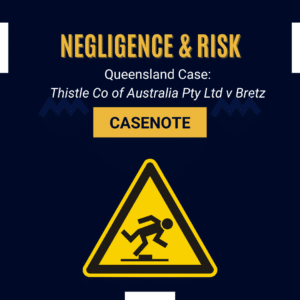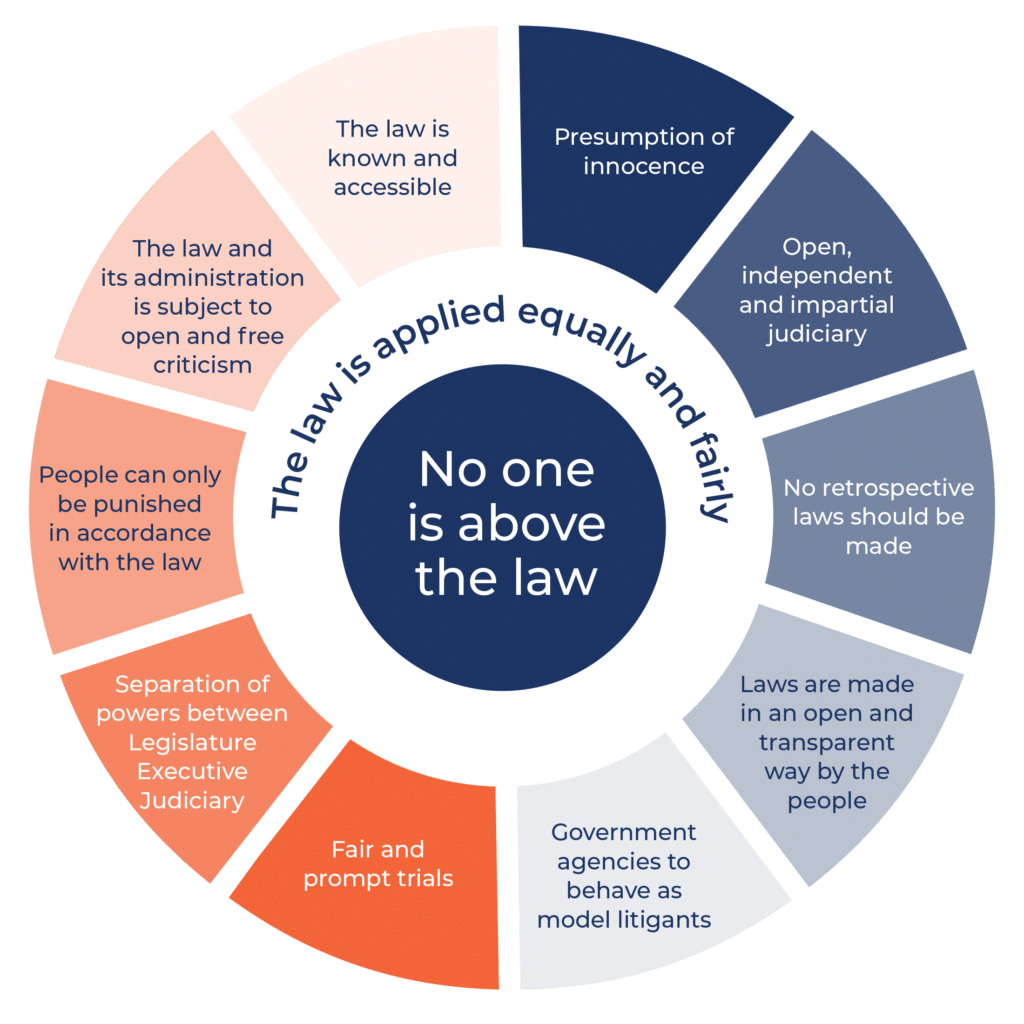Explainer and Case Study on Negligence and Risk
in Queensland
The following Explainer and Case Note on ‘Thistle’s Case‘ examines negligence and the following principles: risk, reasonableness, causation and contributory negligence.
Click here to download the PDF version of the Explainer and Casenote.
Negligence
Civil law, or tort law, protects the rights of individuals and enables them to seek a legal remedy, such as damages, where they have incurred harm or loss. A tort is a legal wrong that is committed by one party or entity (the tortfeasor) against another.
Negligence is the area of tort law that considers the impact of the actions (acts) or inactions (omissions) of a party or entity, on others. Claims in negligence arise when a person has suffered harm or injury (the plaintiff) and they believe that another person or organisation (the defendant) is responsible for the circumstances that caused the injury to occur. They then sue the defendant for damages, or compensation, for the loss incurred.
Negligence is considered to be harm caused without the intention to cause harm. It has occurred as a result of a failure to account for harm that may be caused to others because of acts or omissions.
Elements of Negligence
Negligence is defined in the Oxford Dictionary as a “failure to take care over something.” The tort of negligence has developed over time in common law, and determining whether a party has been negligent is based on four main elements that must be proven.
The elements are:
- that the person being sued (the defendant) owed a duty of care on the facts of the case to the injured person (the plaintiff);
- that the defendant breached that duty of care;
- the actions or inaction of the defendant were the cause of harm to the plaintiff (causation); and
- damage or harm was experienced by the plaintiff because of the breach of duty of care and the actions of the defendant. This element also considers whether it is appropriate to impose full or partial liability on the defendant and the extent of the damage the defendant should be liable for.
Duty of Care
Duty of care refers to the situation where one party has a responsibility to ensure that other persons that may be affected by their actions are safe from harm or loss. This principle, called the neighbour principle, was established in England in the landmark case of Donoghue v Stevenson [1932] AC 562. Prior to this case, a contract had to exist between two parties for a claim of negligence to be made.
Donoghue v Stevenson created the legal concept that duty of care existed to anyone that could be reasonably affected by the acts or omissions of another.
In this case, Mrs Donoghue had become ill after consuming a drink manufactured by Mr Stevenson and issued proceedings against him, based on her belief that he owed her a duty of care to ensure that the product he manufactured was safe to consume. At the time, contract law was well established in common law, but there was no legal principle for duty of care where a contract did not exist between two parties.
The case proceeded to the House of Lords, which found in favour of Mrs Donoghue, establishing:
- the tort of negligence was its own distinct tort and there did not need to be a contract to owe care; and
- the neighbour principle that states that all persons or entities “must take reasonable care to avoid acts or omissions which that can be reasonably foreseen to be likely to injure another person.
For more information regarding this case and the neighbour principle, see:
https://legalheritage.sclqld.org.au/donoghue-v-stevenson-1932-ac-562
https://archive.sclqld.org.au/sclpub/school_resources/snail.pdf
The Onus (Burden) and Standard of Proof in negligence cases
In cases of negligence, the Onus of Proof is on the plaintiff to prove that, on the Balance of Probabilities, the actions or inactions of the defendant resulted in harm or loss to the plaintiff.
The Balance of Probabilities is the standard of proof needed in civil cases. Unlike the standard of beyond reasonable doubt required in criminal cases, the balance of probabilities deals with the likelihood of the actions of the defendant causing harm to the plaintiff. For a finding in favour of the plaintiff, the court must only consider that the weight of evidence supports the fact that the harm was likely to have been caused by the actions or inactions of the defendant. The court can also make findings that both parties contributed in varying amount to the circumstances that resulted in injury.
Remedies
Remedies are the result of a civil court case that has found that the defendant did breach their duty of care to the plaintiff. The purpose of remedies is to restore the individual to their original state, or as close to original as possible, and take the form of compensatory damages – a financial payment to the plaintiff. The amount awarded will vary between cases and may include payment to cover income losses, medical bills, psychological suffering, property damage etc. In cases of negligence, where severe permanent disabilities or loss of life may be the result of the defendant’s actions, the award of an appropriate amount of compensatory damages can be challenging.
Sources of the Law of Negligence
The law of negligence comes from common law (also called ‘case law’ or ‘precedent’) created by judges over many years. In all states and territories, the law has been brought into legislation (‘the Acts’):
- QLD: Civil Liability Act 2003
- NSW: Civil Liability Act 2002
- Victoria: Wrongs Act 1958
- WA: Civil Liability Act 2002
- SA: Civil Liability Act 1936
- Tasmania: Civil Liability Act 2002
- NT: Personal Injuries (Liabilities and Damages) Act 2003
- ACT: Civil Law (Wrongs) Act 2002
Each statute created by the States and Territories have included the common law elements outlined above.
Thistle’s Case: Negligence in Queensland
The Civil Liability Act 2003 (Qld) (‘the Act’) regulates civil claims for damages for harm in Queensland.
To be successful in a claim of negligence in Queensland, plaintiffs must prove a duty of care, as defined in Schedule 2 of the Act, was owed to them by the defendant and prove all of the elements contained in sections 9 and 11, on the balance of probabilities.
Several key concepts arise in these sections of the act, namely risk, reasonableness, causation and contributory negligence.
The following case study examines what these are and how they are applied in a negligence case.
Applying the law
First Instance: Bretz v Thistle Co of Australia Pty Ltd (unreported)
Appeal: Thistle Co of Australia Pty Ltd v Bretz [2018] QCA 006
Facts of the case
On 5 October 2012, Mr Bretz was filling his car and some fuel drums at a petrol station, when he tripped over a concrete base, on which the petrol bowser stood. Mr Bretz suffered injuries to his right shoulder and wrist. He later required surgery to his right shoulder, which was partially injured as a result of his fall. The owner of the petrol station was Thistle Company of Australia Pty Limited (“Thistle”).
The concrete base was the key cause of the damage Mr Bretz had experienced. It previously had a sloping edge and was then redesigned and rebuilt so that it had a square edge. The base had previously been painted yellow, but Thistle arranged for it to be painted black on 9 September 2012, due to the yellow paint being slippery, hard to keep clean and because black matched the black tarmac surface of the roadway.
After the concrete base had been painted black and before Mr Bretz’s fall, a retail manager at the petrol station had warned Thistle at a management meeting that the new black base was harder to see.
Hearing in the First Instance
The initial hearing of this case was held in the District Court of Queensland, where Mr Bretz sued Thistle for damages for the personal injuries he had sustained, because of Thistle’s alleged negligence. Evidence was given at the initial hearing in the District Court that other customers had previously complained about the slipperiness of the concrete base and that people had tripped on it. Mr Bretz succeeded in his claim for damages for negligence against Thistle. Thistle appealed the decision to the Queensland Court of Appeal (QCA).
Key concept: Risk
Schedule 2 of the Act defines of ‘duty of care’ as “a duty to take reasonable care or to exercise reasonable skill (or both).” Section 9 (1) of the Act is centred on assessing risk to determine whether a breach of duty of care has occurred.
In this case, the court addressed the issues of ‘risk’ to determine whether negligence had occurred, with the judgement focussing on two types of risk: obvious risk and insignificant risk.
Section 9 (1)
A person does not breach a duty to take precautions against a risk of harm unless—
a) the risk was reasonably foreseeable; and
b) the risk was not insignificant; and
c) in the circumstances, a reasonable person in the position of the person would have taken the precautions.
Obvious Risk
Obvious risk is defined in section 13 of the Act as being “a risk that, in the circumstances, would have been obvious to a reasonable person in the position of that person.” It is:
- a risk that a person would think was obvious, on the facts of a case (e.g. a reasonable person knows getting in a car, knowing the driver is very drunk, and taking the risk that they may have an accident)
- an argument that the risk is so obvious to a reasonable person, that the defendant should not be held responsible for the injured person not looking out for themselves (e.g. the defendant should not be responsible for the injury from a car accident, as a reasonable person would not have taken the obvious risk of getting into that car with a driver who was drunk)
- a defence that can be used by a defendant against a claim by an injured person
Under section 15 of the Act, there is no duty on a defendant to warn of an obvious risk, creating a defence to negligence. However, if an injured person can show, on the balance of probabilities, that they were not aware of the risk, the defendant will not be able to rely on the defence of obvious risk.
Insignificant Risk
Insignificant risk is:
- a risk of injury that has a low chance of occurring (e.g. getting hit by a cricket ball whilst standing behind a cricketer)
- a risk that a reasonable person thinks a defendant should not have to take steps to avoid for other people, as the chance of it happening is so low (i.e. the chance of a person being hit by a cricket ball when behind the cricketer is not something that the defendant has to avoid)
- an argument that can be used to defend a claim by an injured person
Under section 9 of the Act, a person does not breach their duty of care if the risk to the injured person is found to be insignificant. In the initial case hearing, the defendant argued that the risk of tripping was insignificant. The court did not accept this argument.
Expert evidence had been given that the concrete base created a significant hazard and that the hazard was not easy to see [28]. Complaints had been made previously of customers either slipping or tripping on the concrete base. A staff member had reported her concerns about the risk posed by the new design and colour of the concrete base. These factors meant that the risk was not insignificant [32].
Risk can be a difficult concept to determine as individuals make subjective assessments about risk based on their own experiences, tendency for risk aversion and their own assessment of the situation at that time. This can make knowing the law and abiding by it very difficult in some circumstances and could lead to adverse outcomes for people who understand risk to be different to what others may perceive.
To uphold the Rule of Law and create an objective view of risk to ascertain negligence, the application of the principle of reasonableness allows the court the discretion to make a judgement about what a reasonable person would have considered the risks to be.
Key concept: Reasonableness
In Albrecht v Ainsworth & Ors [2015] QCA 220, the Queensland Court of Appeal held that “the question of reasonableness is objective, requiring a consideration of all relevant circumstances… what will be relevant in determining reasonableness (or unreasonableness) will vary from case to case, depending on the issues raised and the relevant material submitted.”
Reasonableness is a concept that allows for judicial officers to exercise discretion in the application of law. It allows for flexibility in the way the law is applied to the unique circumstances of a case, supporting fair trial outcomes and creating equity and fairness by adjusting the law to account for varied circumstances of the case before them. Reasonableness enables the court to make an objective assessment of the risk associated with acts or omissions to determine whether negligence has occurred.
Key concept: Contributory Negligence
Section 23 of the Act states that contributory negligence will apply, if a plaintiff is found not to have taken reasonable care of themselves, to avoid the injury occurring. The legal principle of contributory negligence means that, if a defendant is found liable for negligence, the damages they must pay can be reduced if the plaintiff is partially at fault for their own injury. This upholds fairness in the system as it recognises that the responsibility of the defendant is limited, and compensation paid by them must be adjusted to account for that.
In such findings, the court’s decision will state that each party is partially responsible for the harm and will decide by way of percentage what portion each party is responsible for (e.g. 60% responsibility for the defendant and 40% responsibility for the plaintiff). The court will award damages and reduce them by the percentage that the plaintiff is found to be responsible (e.g. $100,000 damages less 40% is an award of $60,000 damages to the plaintiff). Section 24 of the Act also provides that the court may even decide on a reduction of 100% if they deem it just and equitable to do so, defeating the plaintiff’s claim altogether.
During the initial hearing, Thistle argued that Mr Bretz had not kept a good lookout at where he was walking. The court did not accept this argument and no contributory negligence was found.
Key concept: Causation
The causation test (also called the ‘but for’ test) provides the link between conduct and harm. It seeks to discover whether the harm experienced by the plaintiff was in fact caused by the conduct of the defendant, meaning that without the conduct, the harm would not have occurred (factual causation). Section 11 of the Act provides for causation.
Bretz v Thistle found that the actions of Thistle (the redesign of the concrete base and its subsequent painting in black) had been the cause of the injury sustained by Mr Bretz.
Section 11
A decision that a breach of duty caused particular harm comprises the following elements:
a) the breach of duty was a necessary condition of the occurrence of the harm (factual causation);
b) it is appropriate for the scope of the liability of the person in breach to extend to the harm so caused (scope of liability).
Civil case outcomes create remedies to restore losses rather than punishments to provide retribution and rehabilitation. If we apply the principles of the Rule of Law Wheel, causation supports the achievement of ‘punishment’ in accordance with the law, as the legal principle of responsibility to the extent of the law is upheld. When the causation test is applied, a defendant cannot be held accountable for actions that are not believed to have caused harm to a plaintiff. The test ensures that the legal responsibility of the defendant is limited to their actions in the circumstances of the alleged harm.
The Appeal
The QCA found that Thistle had been negligent and that it had breached its duty of care by being aware of a reasonably foreseeable risk and not doing anything to avoid it, causing Mr Bretz to fall and suffer his injuries. The three judges decided unanimously that there was sufficient evidence, on the balance of probabilities, for the District Court to find that Thistle was liable (responsible) for negligence and for the damages awarded.
The QCA found that Mr Bretz was not very familiar with the petrol station. He had only been there a few times previously. The concrete base was not high, and it extended out beyond the bowser, which was an unusual design. Experts who gave evidence at the hearing said they had not seen that type of design before. The concrete base was painted black and was hard to see next to the roadway, which was painted the same colour. The retail manager had warned Thistle that this risk was not obvious, but Thistle did nothing about it [19]. The court found that the risk was not obvious to a reasonable person in Mr Bretz’s position [20].
The court dismissed Thistle’s appeal and upheld the damages awarded in the District Court, which came to a total of $96,361.13 plus costs.



